Organisation Theory: Analysing Microsoft's Growth and Structure
VerifiedAdded on 2023/06/08
|9
|2616
|190
Report
AI Summary
This report examines Microsoft's organisational structure, highlighting factors such as company size, processes, strategies, and technology that influence it. It discusses characteristics of the organisational structure, including divisional, functional, and matrix structures, and how Microsoft manages dynamic processes to shape its growth and evolution. The analysis covers the impact of organisational culture, leadership styles, and innovation strategies on Microsoft's success, emphasizing the importance of adapting to market trends, employee satisfaction, and continuous improvement in hardware and software offerings. The report concludes that effective organisational structure, culture, leadership, and innovation are crucial for Microsoft's continued growth and competitive advantage.
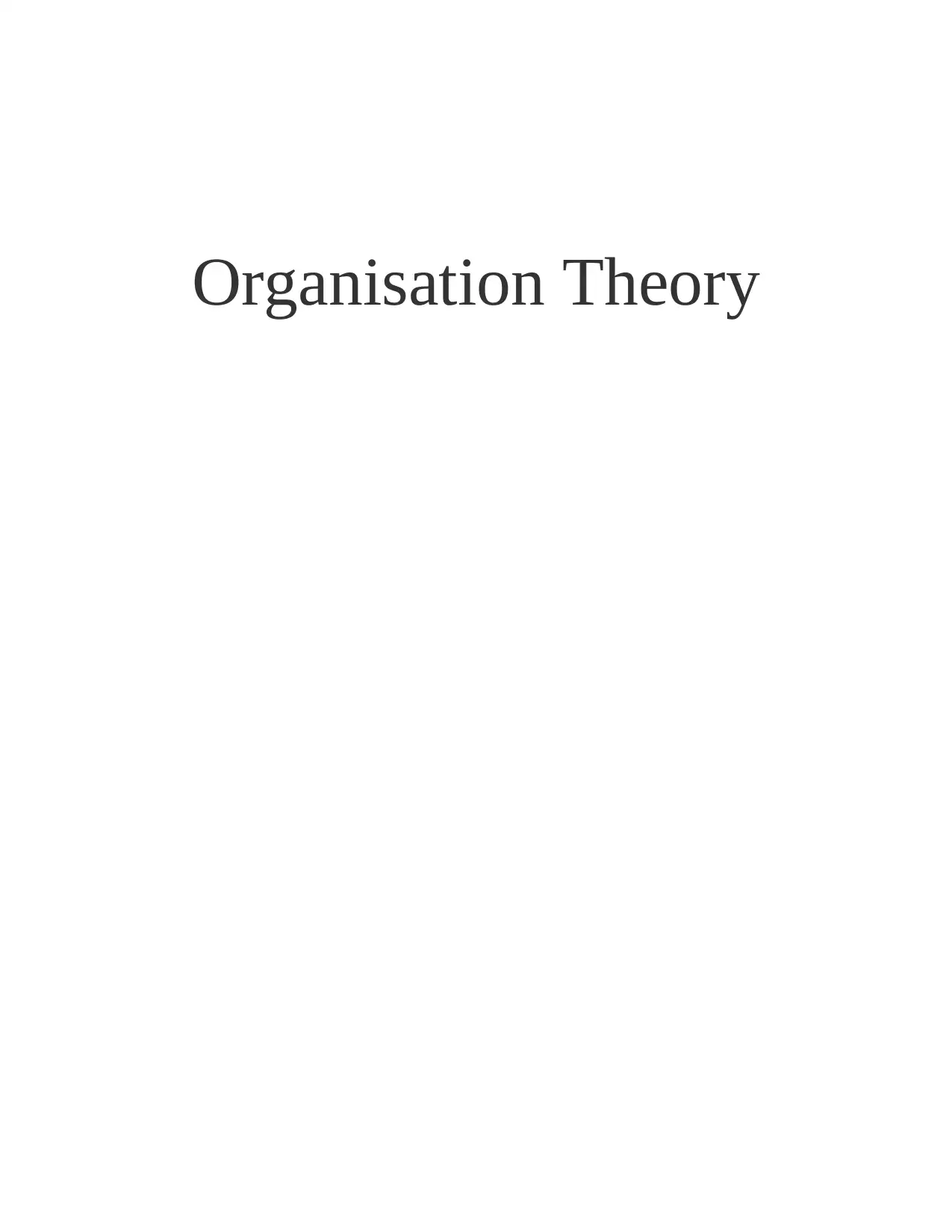
Organisation Theory
Paraphrase This Document
Need a fresh take? Get an instant paraphrase of this document with our AI Paraphraser
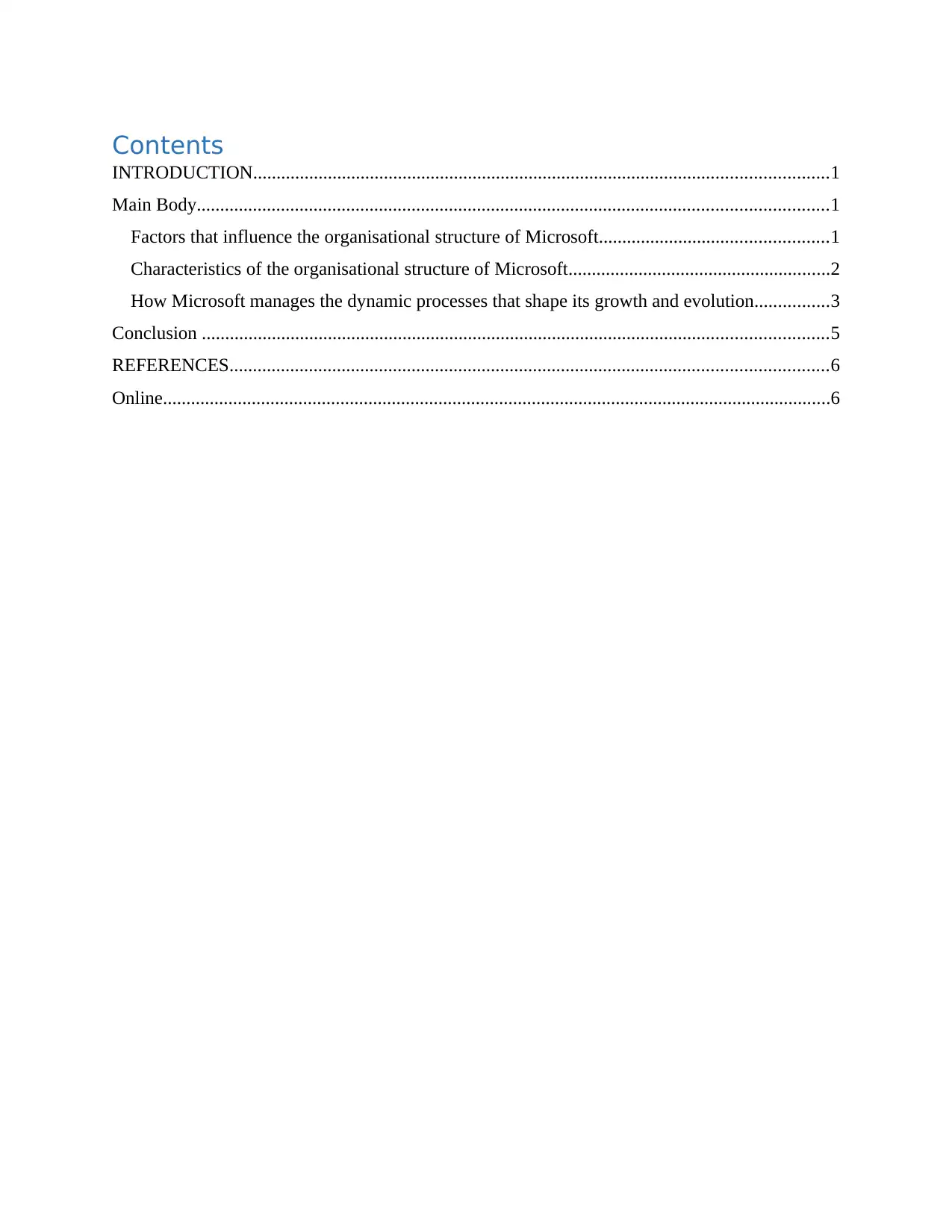
Contents
INTRODUCTION...........................................................................................................................1
Main Body.......................................................................................................................................1
Factors that influence the organisational structure of Microsoft.................................................1
Characteristics of the organisational structure of Microsoft........................................................2
How Microsoft manages the dynamic processes that shape its growth and evolution................3
Conclusion ......................................................................................................................................5
REFERENCES................................................................................................................................6
Online...............................................................................................................................................6
INTRODUCTION...........................................................................................................................1
Main Body.......................................................................................................................................1
Factors that influence the organisational structure of Microsoft.................................................1
Characteristics of the organisational structure of Microsoft........................................................2
How Microsoft manages the dynamic processes that shape its growth and evolution................3
Conclusion ......................................................................................................................................5
REFERENCES................................................................................................................................6
Online...............................................................................................................................................6
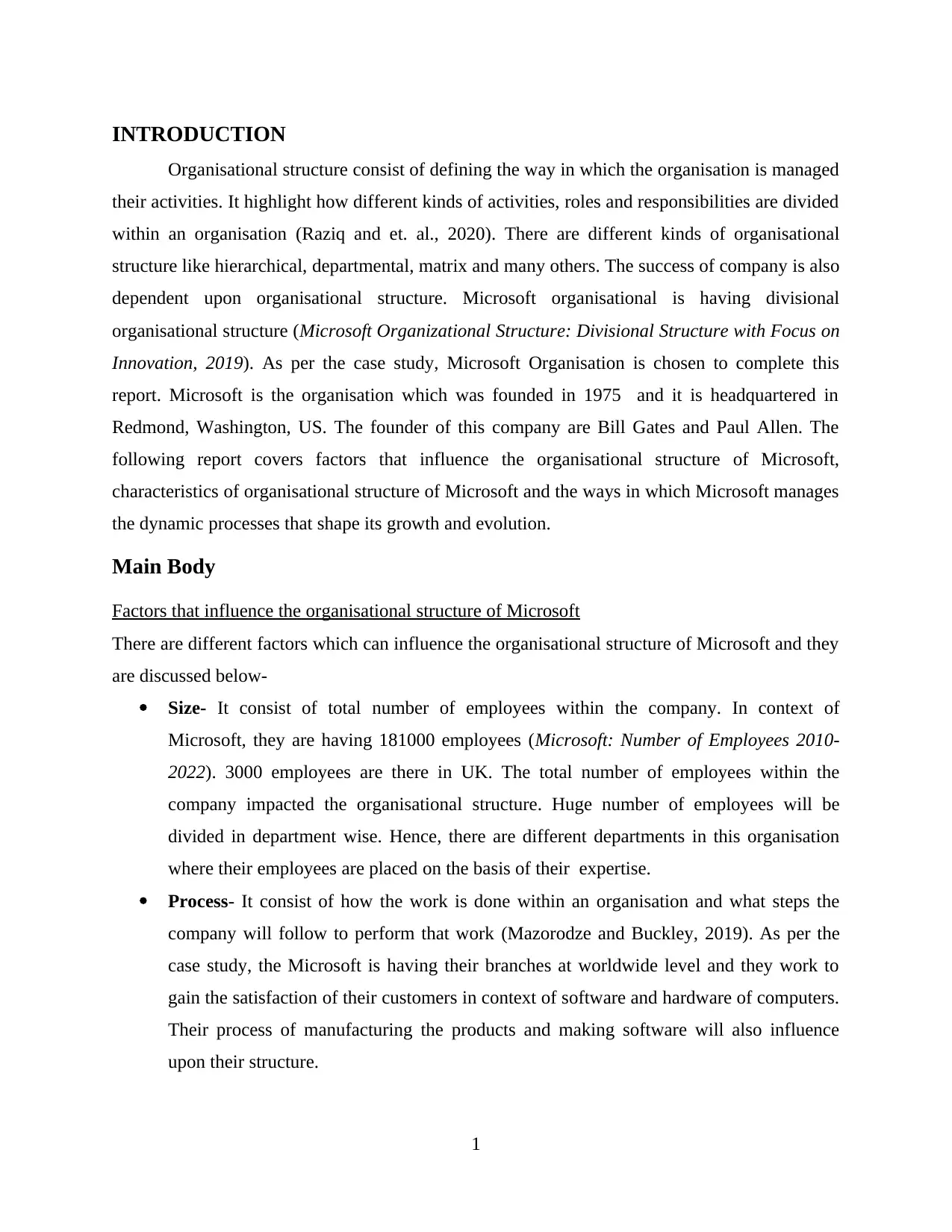
INTRODUCTION
Organisational structure consist of defining the way in which the organisation is managed
their activities. It highlight how different kinds of activities, roles and responsibilities are divided
within an organisation (Raziq and et. al., 2020). There are different kinds of organisational
structure like hierarchical, departmental, matrix and many others. The success of company is also
dependent upon organisational structure. Microsoft organisational is having divisional
organisational structure (Microsoft Organizational Structure: Divisional Structure with Focus on
Innovation, 2019). As per the case study, Microsoft Organisation is chosen to complete this
report. Microsoft is the organisation which was founded in 1975 and it is headquartered in
Redmond, Washington, US. The founder of this company are Bill Gates and Paul Allen. The
following report covers factors that influence the organisational structure of Microsoft,
characteristics of organisational structure of Microsoft and the ways in which Microsoft manages
the dynamic processes that shape its growth and evolution.
Main Body
Factors that influence the organisational structure of Microsoft
There are different factors which can influence the organisational structure of Microsoft and they
are discussed below-
Size- It consist of total number of employees within the company. In context of
Microsoft, they are having 181000 employees (Microsoft: Number of Employees 2010-
2022). 3000 employees are there in UK. The total number of employees within the
company impacted the organisational structure. Huge number of employees will be
divided in department wise. Hence, there are different departments in this organisation
where their employees are placed on the basis of their expertise.
Process- It consist of how the work is done within an organisation and what steps the
company will follow to perform that work (Mazorodze and Buckley, 2019). As per the
case study, the Microsoft is having their branches at worldwide level and they work to
gain the satisfaction of their customers in context of software and hardware of computers.
Their process of manufacturing the products and making software will also influence
upon their structure.
1
Organisational structure consist of defining the way in which the organisation is managed
their activities. It highlight how different kinds of activities, roles and responsibilities are divided
within an organisation (Raziq and et. al., 2020). There are different kinds of organisational
structure like hierarchical, departmental, matrix and many others. The success of company is also
dependent upon organisational structure. Microsoft organisational is having divisional
organisational structure (Microsoft Organizational Structure: Divisional Structure with Focus on
Innovation, 2019). As per the case study, Microsoft Organisation is chosen to complete this
report. Microsoft is the organisation which was founded in 1975 and it is headquartered in
Redmond, Washington, US. The founder of this company are Bill Gates and Paul Allen. The
following report covers factors that influence the organisational structure of Microsoft,
characteristics of organisational structure of Microsoft and the ways in which Microsoft manages
the dynamic processes that shape its growth and evolution.
Main Body
Factors that influence the organisational structure of Microsoft
There are different factors which can influence the organisational structure of Microsoft and they
are discussed below-
Size- It consist of total number of employees within the company. In context of
Microsoft, they are having 181000 employees (Microsoft: Number of Employees 2010-
2022). 3000 employees are there in UK. The total number of employees within the
company impacted the organisational structure. Huge number of employees will be
divided in department wise. Hence, there are different departments in this organisation
where their employees are placed on the basis of their expertise.
Process- It consist of how the work is done within an organisation and what steps the
company will follow to perform that work (Mazorodze and Buckley, 2019). As per the
case study, the Microsoft is having their branches at worldwide level and they work to
gain the satisfaction of their customers in context of software and hardware of computers.
Their process of manufacturing the products and making software will also influence
upon their structure.
1
⊘ This is a preview!⊘
Do you want full access?
Subscribe today to unlock all pages.

Trusted by 1+ million students worldwide
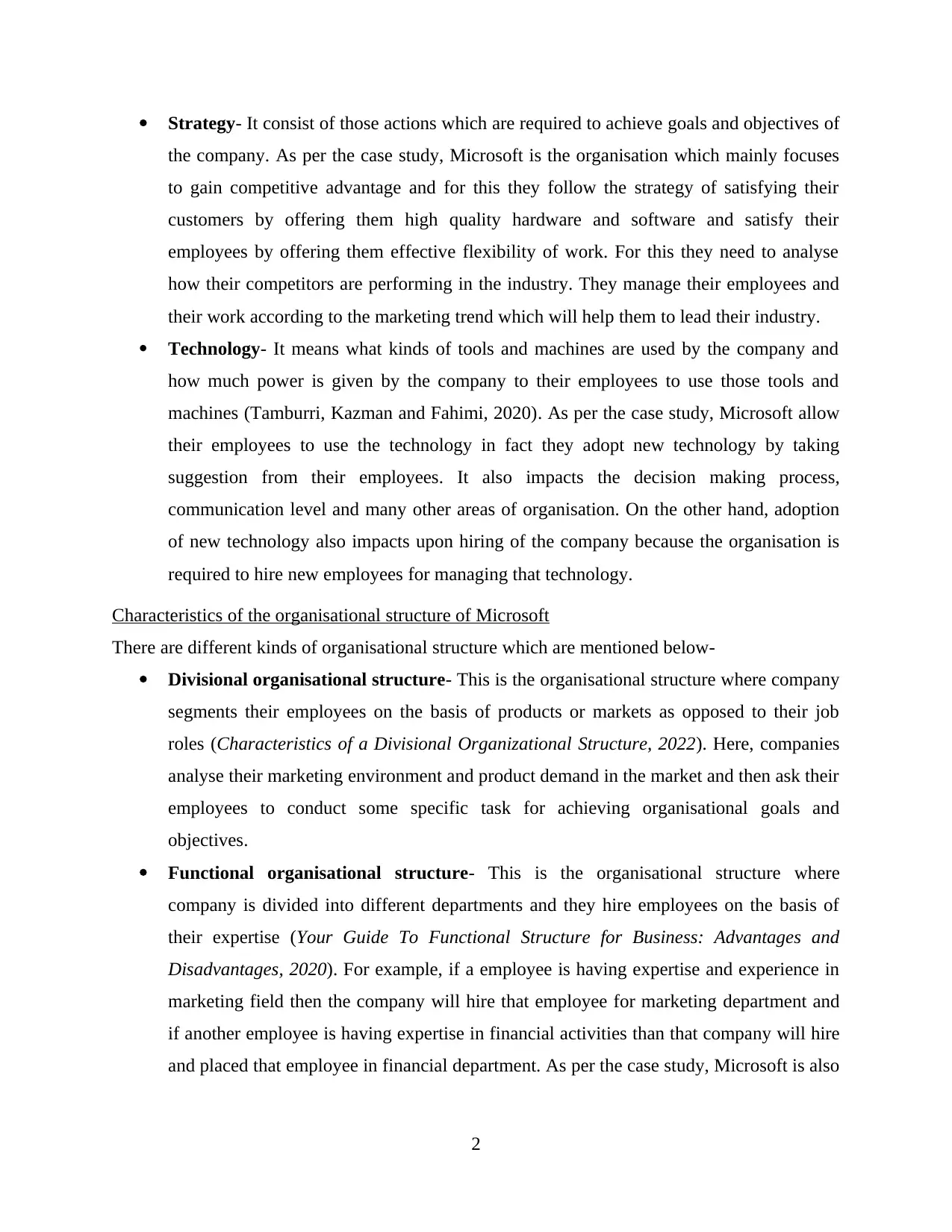
Strategy- It consist of those actions which are required to achieve goals and objectives of
the company. As per the case study, Microsoft is the organisation which mainly focuses
to gain competitive advantage and for this they follow the strategy of satisfying their
customers by offering them high quality hardware and software and satisfy their
employees by offering them effective flexibility of work. For this they need to analyse
how their competitors are performing in the industry. They manage their employees and
their work according to the marketing trend which will help them to lead their industry.
Technology- It means what kinds of tools and machines are used by the company and
how much power is given by the company to their employees to use those tools and
machines (Tamburri, Kazman and Fahimi, 2020). As per the case study, Microsoft allow
their employees to use the technology in fact they adopt new technology by taking
suggestion from their employees. It also impacts the decision making process,
communication level and many other areas of organisation. On the other hand, adoption
of new technology also impacts upon hiring of the company because the organisation is
required to hire new employees for managing that technology.
Characteristics of the organisational structure of Microsoft
There are different kinds of organisational structure which are mentioned below-
Divisional organisational structure- This is the organisational structure where company
segments their employees on the basis of products or markets as opposed to their job
roles (Characteristics of a Divisional Organizational Structure, 2022). Here, companies
analyse their marketing environment and product demand in the market and then ask their
employees to conduct some specific task for achieving organisational goals and
objectives.
Functional organisational structure- This is the organisational structure where
company is divided into different departments and they hire employees on the basis of
their expertise (Your Guide To Functional Structure for Business: Advantages and
Disadvantages, 2020). For example, if a employee is having expertise and experience in
marketing field then the company will hire that employee for marketing department and
if another employee is having expertise in financial activities than that company will hire
and placed that employee in financial department. As per the case study, Microsoft is also
2
the company. As per the case study, Microsoft is the organisation which mainly focuses
to gain competitive advantage and for this they follow the strategy of satisfying their
customers by offering them high quality hardware and software and satisfy their
employees by offering them effective flexibility of work. For this they need to analyse
how their competitors are performing in the industry. They manage their employees and
their work according to the marketing trend which will help them to lead their industry.
Technology- It means what kinds of tools and machines are used by the company and
how much power is given by the company to their employees to use those tools and
machines (Tamburri, Kazman and Fahimi, 2020). As per the case study, Microsoft allow
their employees to use the technology in fact they adopt new technology by taking
suggestion from their employees. It also impacts the decision making process,
communication level and many other areas of organisation. On the other hand, adoption
of new technology also impacts upon hiring of the company because the organisation is
required to hire new employees for managing that technology.
Characteristics of the organisational structure of Microsoft
There are different kinds of organisational structure which are mentioned below-
Divisional organisational structure- This is the organisational structure where company
segments their employees on the basis of products or markets as opposed to their job
roles (Characteristics of a Divisional Organizational Structure, 2022). Here, companies
analyse their marketing environment and product demand in the market and then ask their
employees to conduct some specific task for achieving organisational goals and
objectives.
Functional organisational structure- This is the organisational structure where
company is divided into different departments and they hire employees on the basis of
their expertise (Your Guide To Functional Structure for Business: Advantages and
Disadvantages, 2020). For example, if a employee is having expertise and experience in
marketing field then the company will hire that employee for marketing department and
if another employee is having expertise in financial activities than that company will hire
and placed that employee in financial department. As per the case study, Microsoft is also
2
Paraphrase This Document
Need a fresh take? Get an instant paraphrase of this document with our AI Paraphraser
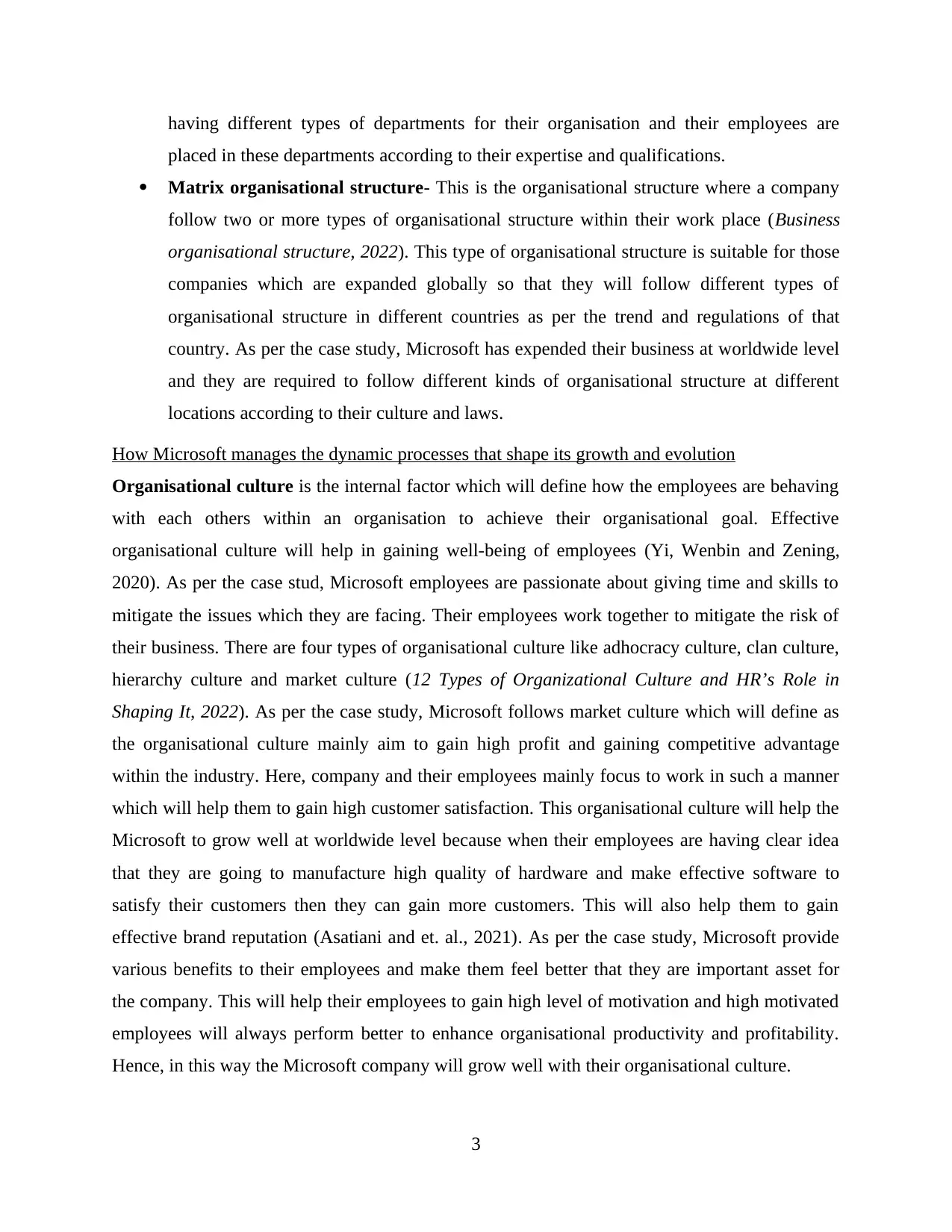
having different types of departments for their organisation and their employees are
placed in these departments according to their expertise and qualifications.
Matrix organisational structure- This is the organisational structure where a company
follow two or more types of organisational structure within their work place (Business
organisational structure, 2022). This type of organisational structure is suitable for those
companies which are expanded globally so that they will follow different types of
organisational structure in different countries as per the trend and regulations of that
country. As per the case study, Microsoft has expended their business at worldwide level
and they are required to follow different kinds of organisational structure at different
locations according to their culture and laws.
How Microsoft manages the dynamic processes that shape its growth and evolution
Organisational culture is the internal factor which will define how the employees are behaving
with each others within an organisation to achieve their organisational goal. Effective
organisational culture will help in gaining well-being of employees (Yi, Wenbin and Zening,
2020). As per the case stud, Microsoft employees are passionate about giving time and skills to
mitigate the issues which they are facing. Their employees work together to mitigate the risk of
their business. There are four types of organisational culture like adhocracy culture, clan culture,
hierarchy culture and market culture (12 Types of Organizational Culture and HR’s Role in
Shaping It, 2022). As per the case study, Microsoft follows market culture which will define as
the organisational culture mainly aim to gain high profit and gaining competitive advantage
within the industry. Here, company and their employees mainly focus to work in such a manner
which will help them to gain high customer satisfaction. This organisational culture will help the
Microsoft to grow well at worldwide level because when their employees are having clear idea
that they are going to manufacture high quality of hardware and make effective software to
satisfy their customers then they can gain more customers. This will also help them to gain
effective brand reputation (Asatiani and et. al., 2021). As per the case study, Microsoft provide
various benefits to their employees and make them feel better that they are important asset for
the company. This will help their employees to gain high level of motivation and high motivated
employees will always perform better to enhance organisational productivity and profitability.
Hence, in this way the Microsoft company will grow well with their organisational culture.
3
placed in these departments according to their expertise and qualifications.
Matrix organisational structure- This is the organisational structure where a company
follow two or more types of organisational structure within their work place (Business
organisational structure, 2022). This type of organisational structure is suitable for those
companies which are expanded globally so that they will follow different types of
organisational structure in different countries as per the trend and regulations of that
country. As per the case study, Microsoft has expended their business at worldwide level
and they are required to follow different kinds of organisational structure at different
locations according to their culture and laws.
How Microsoft manages the dynamic processes that shape its growth and evolution
Organisational culture is the internal factor which will define how the employees are behaving
with each others within an organisation to achieve their organisational goal. Effective
organisational culture will help in gaining well-being of employees (Yi, Wenbin and Zening,
2020). As per the case stud, Microsoft employees are passionate about giving time and skills to
mitigate the issues which they are facing. Their employees work together to mitigate the risk of
their business. There are four types of organisational culture like adhocracy culture, clan culture,
hierarchy culture and market culture (12 Types of Organizational Culture and HR’s Role in
Shaping It, 2022). As per the case study, Microsoft follows market culture which will define as
the organisational culture mainly aim to gain high profit and gaining competitive advantage
within the industry. Here, company and their employees mainly focus to work in such a manner
which will help them to gain high customer satisfaction. This organisational culture will help the
Microsoft to grow well at worldwide level because when their employees are having clear idea
that they are going to manufacture high quality of hardware and make effective software to
satisfy their customers then they can gain more customers. This will also help them to gain
effective brand reputation (Asatiani and et. al., 2021). As per the case study, Microsoft provide
various benefits to their employees and make them feel better that they are important asset for
the company. This will help their employees to gain high level of motivation and high motivated
employees will always perform better to enhance organisational productivity and profitability.
Hence, in this way the Microsoft company will grow well with their organisational culture.
3
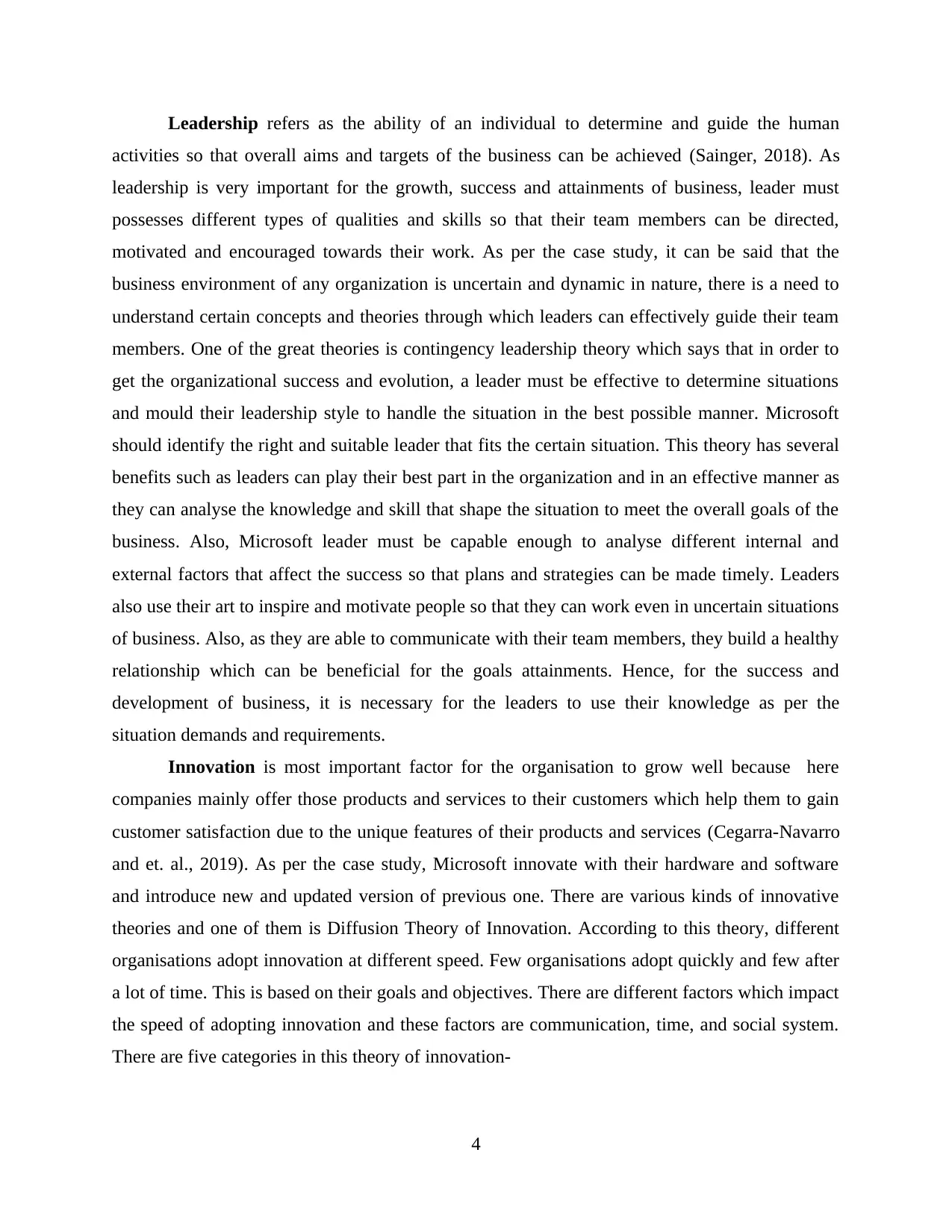
Leadership refers as the ability of an individual to determine and guide the human
activities so that overall aims and targets of the business can be achieved (Sainger, 2018). As
leadership is very important for the growth, success and attainments of business, leader must
possesses different types of qualities and skills so that their team members can be directed,
motivated and encouraged towards their work. As per the case study, it can be said that the
business environment of any organization is uncertain and dynamic in nature, there is a need to
understand certain concepts and theories through which leaders can effectively guide their team
members. One of the great theories is contingency leadership theory which says that in order to
get the organizational success and evolution, a leader must be effective to determine situations
and mould their leadership style to handle the situation in the best possible manner. Microsoft
should identify the right and suitable leader that fits the certain situation. This theory has several
benefits such as leaders can play their best part in the organization and in an effective manner as
they can analyse the knowledge and skill that shape the situation to meet the overall goals of the
business. Also, Microsoft leader must be capable enough to analyse different internal and
external factors that affect the success so that plans and strategies can be made timely. Leaders
also use their art to inspire and motivate people so that they can work even in uncertain situations
of business. Also, as they are able to communicate with their team members, they build a healthy
relationship which can be beneficial for the goals attainments. Hence, for the success and
development of business, it is necessary for the leaders to use their knowledge as per the
situation demands and requirements.
Innovation is most important factor for the organisation to grow well because here
companies mainly offer those products and services to their customers which help them to gain
customer satisfaction due to the unique features of their products and services (Cegarra-Navarro
and et. al., 2019). As per the case study, Microsoft innovate with their hardware and software
and introduce new and updated version of previous one. There are various kinds of innovative
theories and one of them is Diffusion Theory of Innovation. According to this theory, different
organisations adopt innovation at different speed. Few organisations adopt quickly and few after
a lot of time. This is based on their goals and objectives. There are different factors which impact
the speed of adopting innovation and these factors are communication, time, and social system.
There are five categories in this theory of innovation-
4
activities so that overall aims and targets of the business can be achieved (Sainger, 2018). As
leadership is very important for the growth, success and attainments of business, leader must
possesses different types of qualities and skills so that their team members can be directed,
motivated and encouraged towards their work. As per the case study, it can be said that the
business environment of any organization is uncertain and dynamic in nature, there is a need to
understand certain concepts and theories through which leaders can effectively guide their team
members. One of the great theories is contingency leadership theory which says that in order to
get the organizational success and evolution, a leader must be effective to determine situations
and mould their leadership style to handle the situation in the best possible manner. Microsoft
should identify the right and suitable leader that fits the certain situation. This theory has several
benefits such as leaders can play their best part in the organization and in an effective manner as
they can analyse the knowledge and skill that shape the situation to meet the overall goals of the
business. Also, Microsoft leader must be capable enough to analyse different internal and
external factors that affect the success so that plans and strategies can be made timely. Leaders
also use their art to inspire and motivate people so that they can work even in uncertain situations
of business. Also, as they are able to communicate with their team members, they build a healthy
relationship which can be beneficial for the goals attainments. Hence, for the success and
development of business, it is necessary for the leaders to use their knowledge as per the
situation demands and requirements.
Innovation is most important factor for the organisation to grow well because here
companies mainly offer those products and services to their customers which help them to gain
customer satisfaction due to the unique features of their products and services (Cegarra-Navarro
and et. al., 2019). As per the case study, Microsoft innovate with their hardware and software
and introduce new and updated version of previous one. There are various kinds of innovative
theories and one of them is Diffusion Theory of Innovation. According to this theory, different
organisations adopt innovation at different speed. Few organisations adopt quickly and few after
a lot of time. This is based on their goals and objectives. There are different factors which impact
the speed of adopting innovation and these factors are communication, time, and social system.
There are five categories in this theory of innovation-
4
⊘ This is a preview!⊘
Do you want full access?
Subscribe today to unlock all pages.

Trusted by 1+ million students worldwide
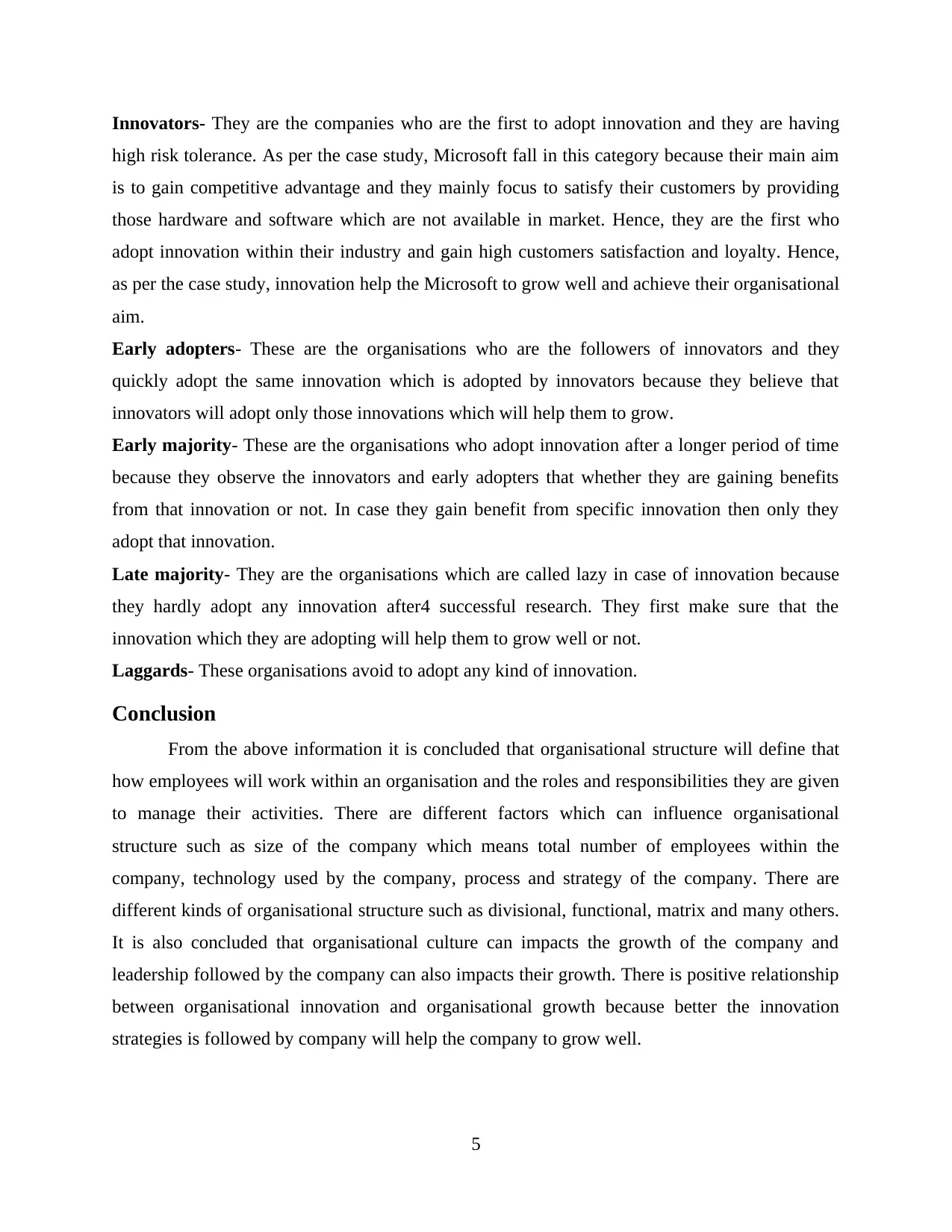
Innovators- They are the companies who are the first to adopt innovation and they are having
high risk tolerance. As per the case study, Microsoft fall in this category because their main aim
is to gain competitive advantage and they mainly focus to satisfy their customers by providing
those hardware and software which are not available in market. Hence, they are the first who
adopt innovation within their industry and gain high customers satisfaction and loyalty. Hence,
as per the case study, innovation help the Microsoft to grow well and achieve their organisational
aim.
Early adopters- These are the organisations who are the followers of innovators and they
quickly adopt the same innovation which is adopted by innovators because they believe that
innovators will adopt only those innovations which will help them to grow.
Early majority- These are the organisations who adopt innovation after a longer period of time
because they observe the innovators and early adopters that whether they are gaining benefits
from that innovation or not. In case they gain benefit from specific innovation then only they
adopt that innovation.
Late majority- They are the organisations which are called lazy in case of innovation because
they hardly adopt any innovation after4 successful research. They first make sure that the
innovation which they are adopting will help them to grow well or not.
Laggards- These organisations avoid to adopt any kind of innovation.
Conclusion
From the above information it is concluded that organisational structure will define that
how employees will work within an organisation and the roles and responsibilities they are given
to manage their activities. There are different factors which can influence organisational
structure such as size of the company which means total number of employees within the
company, technology used by the company, process and strategy of the company. There are
different kinds of organisational structure such as divisional, functional, matrix and many others.
It is also concluded that organisational culture can impacts the growth of the company and
leadership followed by the company can also impacts their growth. There is positive relationship
between organisational innovation and organisational growth because better the innovation
strategies is followed by company will help the company to grow well.
5
high risk tolerance. As per the case study, Microsoft fall in this category because their main aim
is to gain competitive advantage and they mainly focus to satisfy their customers by providing
those hardware and software which are not available in market. Hence, they are the first who
adopt innovation within their industry and gain high customers satisfaction and loyalty. Hence,
as per the case study, innovation help the Microsoft to grow well and achieve their organisational
aim.
Early adopters- These are the organisations who are the followers of innovators and they
quickly adopt the same innovation which is adopted by innovators because they believe that
innovators will adopt only those innovations which will help them to grow.
Early majority- These are the organisations who adopt innovation after a longer period of time
because they observe the innovators and early adopters that whether they are gaining benefits
from that innovation or not. In case they gain benefit from specific innovation then only they
adopt that innovation.
Late majority- They are the organisations which are called lazy in case of innovation because
they hardly adopt any innovation after4 successful research. They first make sure that the
innovation which they are adopting will help them to grow well or not.
Laggards- These organisations avoid to adopt any kind of innovation.
Conclusion
From the above information it is concluded that organisational structure will define that
how employees will work within an organisation and the roles and responsibilities they are given
to manage their activities. There are different factors which can influence organisational
structure such as size of the company which means total number of employees within the
company, technology used by the company, process and strategy of the company. There are
different kinds of organisational structure such as divisional, functional, matrix and many others.
It is also concluded that organisational culture can impacts the growth of the company and
leadership followed by the company can also impacts their growth. There is positive relationship
between organisational innovation and organisational growth because better the innovation
strategies is followed by company will help the company to grow well.
5
Paraphrase This Document
Need a fresh take? Get an instant paraphrase of this document with our AI Paraphraser
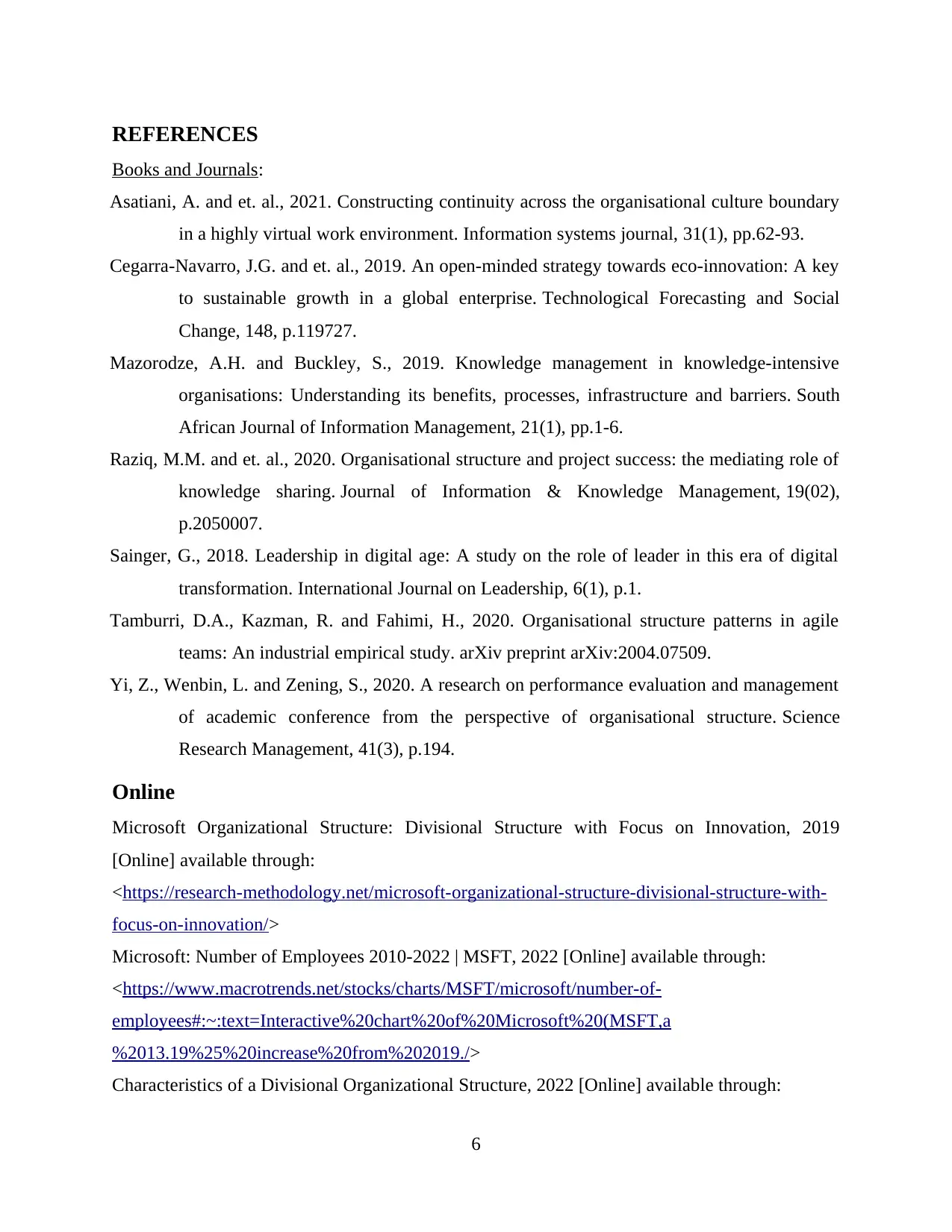
REFERENCES
Books and Journals:
Asatiani, A. and et. al., 2021. Constructing continuity across the organisational culture boundary
in a highly virtual work environment. Information systems journal, 31(1), pp.62-93.
Cegarra-Navarro, J.G. and et. al., 2019. An open-minded strategy towards eco-innovation: A key
to sustainable growth in a global enterprise. Technological Forecasting and Social
Change, 148, p.119727.
Mazorodze, A.H. and Buckley, S., 2019. Knowledge management in knowledge-intensive
organisations: Understanding its benefits, processes, infrastructure and barriers. South
African Journal of Information Management, 21(1), pp.1-6.
Raziq, M.M. and et. al., 2020. Organisational structure and project success: the mediating role of
knowledge sharing. Journal of Information & Knowledge Management, 19(02),
p.2050007.
Sainger, G., 2018. Leadership in digital age: A study on the role of leader in this era of digital
transformation. International Journal on Leadership, 6(1), p.1.
Tamburri, D.A., Kazman, R. and Fahimi, H., 2020. Organisational structure patterns in agile
teams: An industrial empirical study. arXiv preprint arXiv:2004.07509.
Yi, Z., Wenbin, L. and Zening, S., 2020. A research on performance evaluation and management
of academic conference from the perspective of organisational structure. Science
Research Management, 41(3), p.194.
Online
Microsoft Organizational Structure: Divisional Structure with Focus on Innovation, 2019
[Online] available through:
<https://research-methodology.net/microsoft-organizational-structure-divisional-structure-with-
focus-on-innovation/>
Microsoft: Number of Employees 2010-2022 | MSFT, 2022 [Online] available through:
<https://www.macrotrends.net/stocks/charts/MSFT/microsoft/number-of-
employees#:~:text=Interactive%20chart%20of%20Microsoft%20(MSFT,a
%2013.19%25%20increase%20from%202019./>
Characteristics of a Divisional Organizational Structure, 2022 [Online] available through:
6
Books and Journals:
Asatiani, A. and et. al., 2021. Constructing continuity across the organisational culture boundary
in a highly virtual work environment. Information systems journal, 31(1), pp.62-93.
Cegarra-Navarro, J.G. and et. al., 2019. An open-minded strategy towards eco-innovation: A key
to sustainable growth in a global enterprise. Technological Forecasting and Social
Change, 148, p.119727.
Mazorodze, A.H. and Buckley, S., 2019. Knowledge management in knowledge-intensive
organisations: Understanding its benefits, processes, infrastructure and barriers. South
African Journal of Information Management, 21(1), pp.1-6.
Raziq, M.M. and et. al., 2020. Organisational structure and project success: the mediating role of
knowledge sharing. Journal of Information & Knowledge Management, 19(02),
p.2050007.
Sainger, G., 2018. Leadership in digital age: A study on the role of leader in this era of digital
transformation. International Journal on Leadership, 6(1), p.1.
Tamburri, D.A., Kazman, R. and Fahimi, H., 2020. Organisational structure patterns in agile
teams: An industrial empirical study. arXiv preprint arXiv:2004.07509.
Yi, Z., Wenbin, L. and Zening, S., 2020. A research on performance evaluation and management
of academic conference from the perspective of organisational structure. Science
Research Management, 41(3), p.194.
Online
Microsoft Organizational Structure: Divisional Structure with Focus on Innovation, 2019
[Online] available through:
<https://research-methodology.net/microsoft-organizational-structure-divisional-structure-with-
focus-on-innovation/>
Microsoft: Number of Employees 2010-2022 | MSFT, 2022 [Online] available through:
<https://www.macrotrends.net/stocks/charts/MSFT/microsoft/number-of-
employees#:~:text=Interactive%20chart%20of%20Microsoft%20(MSFT,a
%2013.19%25%20increase%20from%202019./>
Characteristics of a Divisional Organizational Structure, 2022 [Online] available through:
6
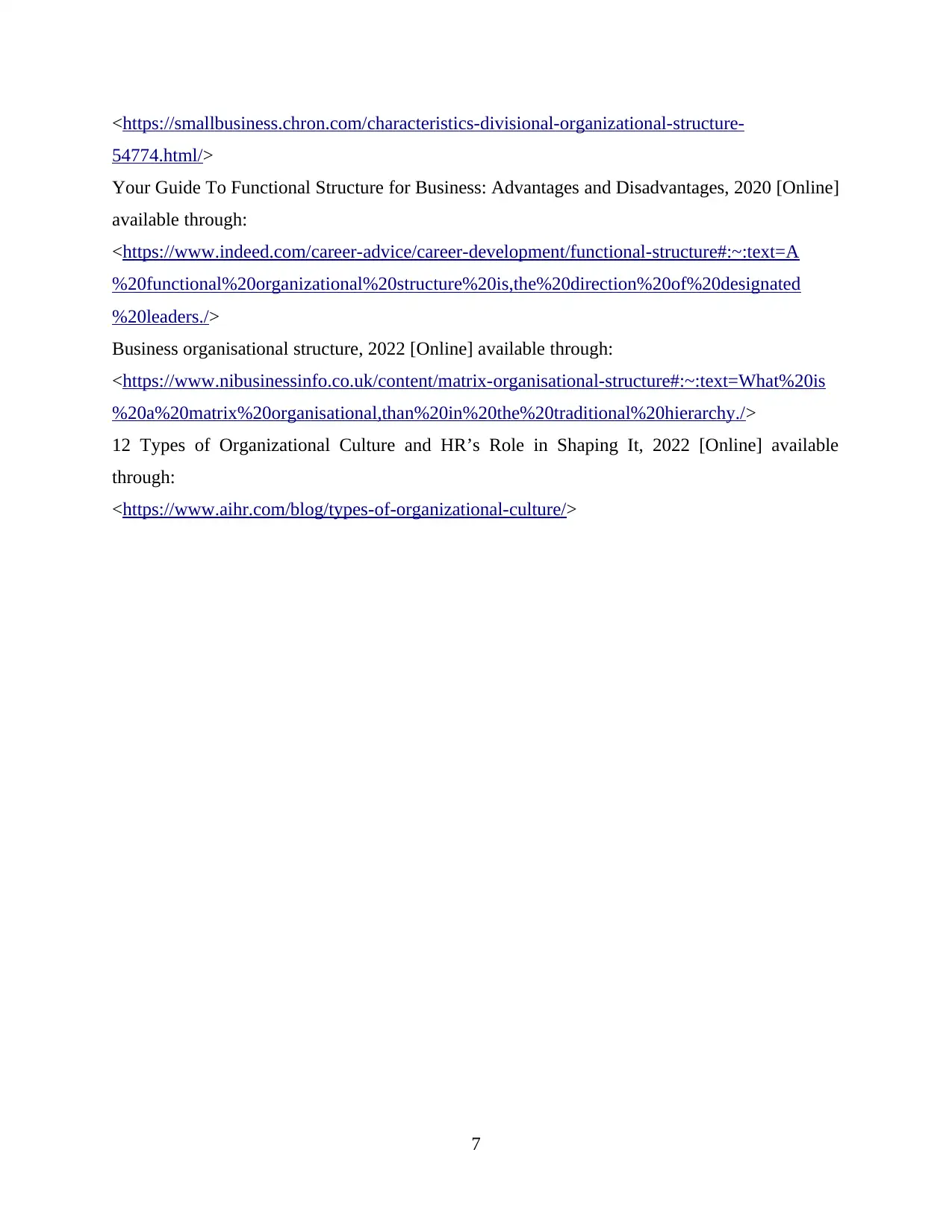
<https://smallbusiness.chron.com/characteristics-divisional-organizational-structure-
54774.html/>
Your Guide To Functional Structure for Business: Advantages and Disadvantages, 2020 [Online]
available through:
<https://www.indeed.com/career-advice/career-development/functional-structure#:~:text=A
%20functional%20organizational%20structure%20is,the%20direction%20of%20designated
%20leaders./>
Business organisational structure, 2022 [Online] available through:
<https://www.nibusinessinfo.co.uk/content/matrix-organisational-structure#:~:text=What%20is
%20a%20matrix%20organisational,than%20in%20the%20traditional%20hierarchy./>
12 Types of Organizational Culture and HR’s Role in Shaping It, 2022 [Online] available
through:
<https://www.aihr.com/blog/types-of-organizational-culture/>
7
54774.html/>
Your Guide To Functional Structure for Business: Advantages and Disadvantages, 2020 [Online]
available through:
<https://www.indeed.com/career-advice/career-development/functional-structure#:~:text=A
%20functional%20organizational%20structure%20is,the%20direction%20of%20designated
%20leaders./>
Business organisational structure, 2022 [Online] available through:
<https://www.nibusinessinfo.co.uk/content/matrix-organisational-structure#:~:text=What%20is
%20a%20matrix%20organisational,than%20in%20the%20traditional%20hierarchy./>
12 Types of Organizational Culture and HR’s Role in Shaping It, 2022 [Online] available
through:
<https://www.aihr.com/blog/types-of-organizational-culture/>
7
⊘ This is a preview!⊘
Do you want full access?
Subscribe today to unlock all pages.

Trusted by 1+ million students worldwide
1 out of 9
Related Documents
Your All-in-One AI-Powered Toolkit for Academic Success.
+13062052269
info@desklib.com
Available 24*7 on WhatsApp / Email
![[object Object]](/_next/static/media/star-bottom.7253800d.svg)
Unlock your academic potential
Copyright © 2020–2025 A2Z Services. All Rights Reserved. Developed and managed by ZUCOL.



